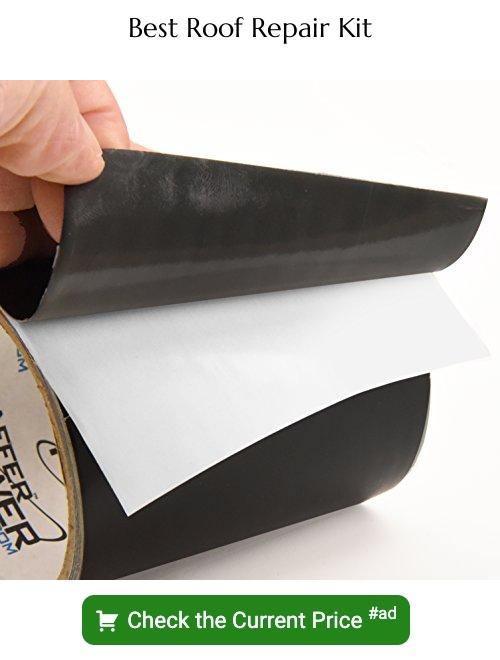Last updated on
This article provides a step-by-step guide on how to effectively patch a hole in your roof.
Key takeaways:
- Weather damage, age, animals, fallen limbs, improper installation cause roof holes.
- Prioritize safety: wear non-slip shoes, use sturdy ladder, consider safety harness.
- Step by step: identify damage, gather materials, prepare area, cut patch, apply cement, place patch, secure patch, seal edges, inspect work.
- Consider hiring professional roofer for time-saving and high-quality repairs.
- Roof holes can be filled with tar, wood, or using a specially designed kit.
Why Your Roof May Require Patching

Roofs can develop holes due to a variety of factors:
1. Weather Damage: Intense conditions such as hail, strong winds, or heavy rain can dislodge roofing materials or cause debris to puncture the surface.
2. Age-Related Wear: Over time, roofing materials deteriorate, which can create weak spots that eventually turn into holes.
3. Animal Activity: Birds, squirrels, or rodents may create holes in the roof as they seek shelter or attempt to nest.
4. Fallen Limbs: Tree branches that fall during storms can puncture roofing materials, leading to holes that require patching.
5. Improper Installation: If roofing materials were not properly installed, they might leave gaps or holes that can allow water ingress.
6. Corrosion: Roofs made of metal can corrode over time, especially if not properly maintained, leading to the development of holes.
Repairing these issues promptly helps prevent further damage such as water leaks that can compromise structural integrity and lead to costly repairs.
Safety Considerations for DIY Roof Repair
Prioritize personal safety when attempting DIY roof repair. Wear non-slip shoes with good traction to prevent falls. Use a sturdy ladder, ensuring it’s securely positioned before ascending. Consider a safety harness, especially on steep roofs. Avoid wet conditions as they increase the risk of slipping. Lastly, never work alone; always have someone nearby to assist in case of emergencies.
Step By Step Guide to Patching a Roof
1. Identify the damage: Locate the hole and the surrounding area that might be compromised. This could be missing shingles, damaged flashing, or a visible opening in the roof decking.
2. Gather materials: Obtain roofing cement, a putty knife, roofing nails, a hammer, a piece of galvanized sheet metal or a roofing patch that matches your roof material, and proper safety gear.
3. Prepare the area: Clear any debris and clean the area around the hole. The surface should be dry and free of dust and dirt to ensure the patch adheres well.
4. Cut the patch: Your patching material should be cut to size, extending at least 2 inches beyond the damaged area on all sides. Round the corners of the metal patch to prevent lifting.
5. Apply roofing cement: Use a putty knife to spread a liberal amount of roofing cement around the hole. This will help the patch create a waterproof seal.
6. Place the patch: Carefully lay the patch over the hole, pressing firmly into the cement. Ensure it’s flat and smooth against the roof.
7. Secure the patch: Nail the patch into place using roofing nails, spaced every 3-4 inches along the perimeter of the patch.
8. Seal the edges: Apply a final layer of roofing cement over the edges of the patch, covering the nails, to create a water-tight barrier.
9. Inspect your work: Ensure the patch is firm and the edges are well sealed. Check for any gaps that may allow water penetration.
Remember, working on a roof can be dangerous. If you’re uncomfortable or unsure about repairing the hole safely, consulting a professional is advised.
Professional Help Is Available
Hiring a professional roofer can often save time and ensure high-quality work. Experienced contractors possess the necessary skills, tools, and materials to repair roof holes efficiently. They can also identify any underlying issues causing the damage.
Moreover, professionals can offer warranties on their work, providing added peace of mind. When selecting a roofing expert, consider their credentials, customer reviews, and insurance status. Always obtain multiple quotes to ensure competitive pricing for your roof repair needs.
FAQ
What do you fill roof holes with?
Roof holes can be effectively filled by using roofing tar to seal the gaps around the patch’s edges, laying tar paper over the hole extending underneath the top row of shingles, and finally nailing the tar paper to the decking.
What can I use to close a hole in my roof?
To close a hole in your roof, you can either employ a professional roofing service or use materials like wood and roofing tar, or purchase a specially designed kit.
Can you fix a small hole in a roof from the inside?
Yes, as long as the hole is small, it is feasible to fix a roof leak from the inside, typically, from the attic.
How do you temporarily seal a hole in a roof?
A temporary solution to sealing a hole in a roof involves mixing water with a cement-like powder and pouring it into the opening, which dries to a solid form stopping water leakages.
What materials are needed for patching a small hole in the roof?
To patch a small hole in the roof, you will need roofing cement, a putty knife, roofing fabric, roofing nails, and a hammer.
How does the hole size affect the method used to patch a roof?
The size of the hole significantly influences the method used to patch a roof, with smaller holes often requiring simpler patching materials like roofing cement, while larger holes might necessitate a more complex process involving roof shingles or metal flashing.
Is professional assistance necessary for larger holes in the roof?
Yes, larger holes in a roof typically require professional assistance for a proper and safe repair.





